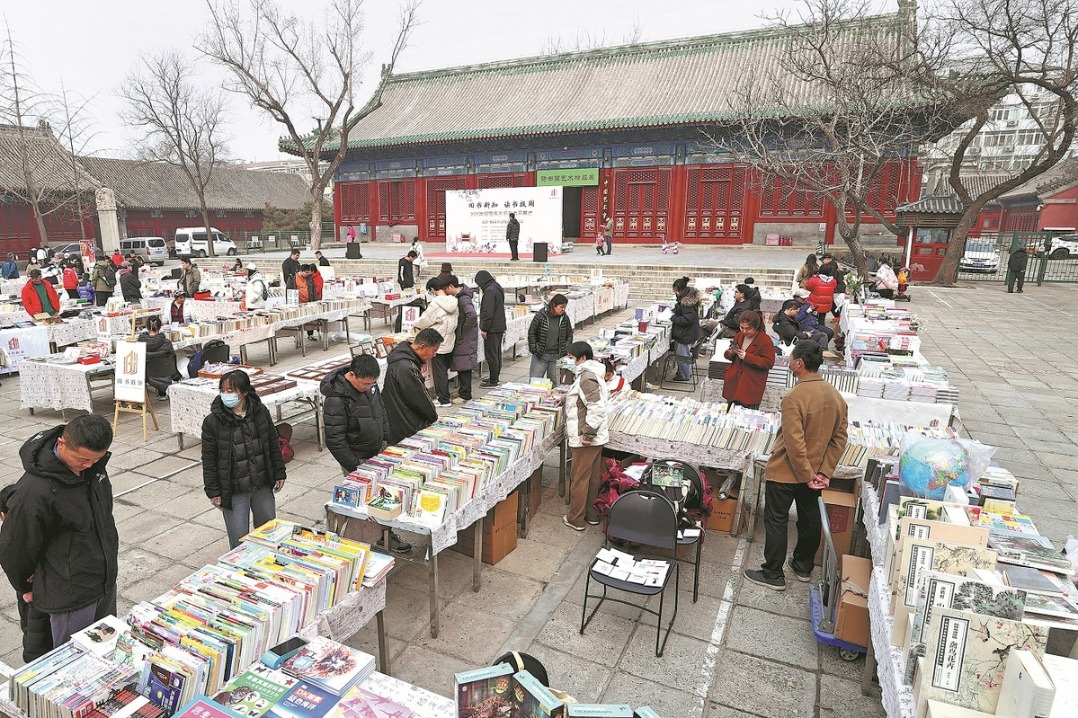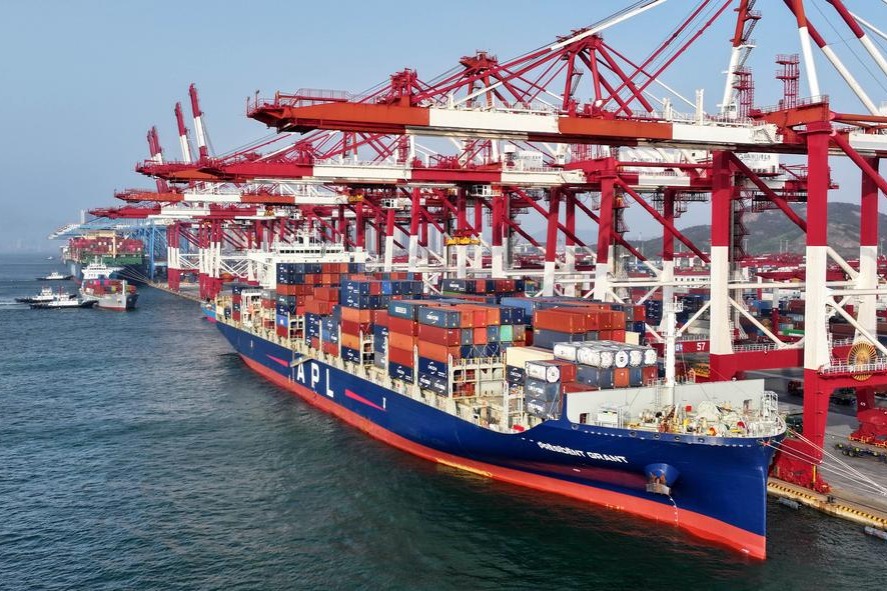Countering monetary shockwaves


Beijing must advance the dual-circulation development strategy, accelerate the diversification of its foreign exchange reserves and prudently advance the internationalization of the renminbi
With the collapse of the Bretton Woods system in the early 1970s, the international monetary system entered the era of the Jamaica System. Also known as the US dollar-standard system, this arrangement saw the US dollar — no longer pegged to gold — retain its role as the dominant global currency. Under this dollar standard, the anchor for global currencies shifted from gold to the credibility of the US central bank. In other words, global investors tend to believe that the Federal Reserve, with its strong independence, is committed to maintaining domestic price stability in the United States. Consequently, the Fed controls dollar issuance within reasonable bounds. This approach helps sustain the dollar's purchasing power and exchange rate stability, thus preserving its status as the world's primary reserve currency.
However, over time — particularly since the dawn of the 21st century — the functioning of the dollar standard has increasingly encountered three major challenges.
The first is the "generalized Triffin dilemma". Over recent decades, the US has primarily supplied dollars to the world through persistent current account deficits (primarily in goods trade). However, these chronic deficits have caused the US net foreign debt to rise continuously. On the one hand, to meet the growing global demand for dollar liquidity, Washington must sustain these deficits, increasing its external liabilities. On the other hand, as the debt burden keeps growing, once it surpasses a threshold deemed unsustainable by investors, their trust in US debt could collapse, triggering a widespread sell-off of dollar-denominated assets. In short, the ongoing accumulation of US government's external debt will ultimately threaten the dollar's status as the global currency.
The second challenge lies in the Fed's predominantly domestic focus when formulating monetary policy, often overlooking the potential negative spillover effects on other economies. For instance, during Fed easing cycles, emerging markets and developing economies typically experience large-scale capital inflows, leading to currency appreciation, rising inflation and surging asset prices. Conversely, when the Fed tightens, these countries often face currency depreciation, collapsing asset bubbles and economic stagnation. Yet, the US government frequently disregards these negative externalities of its economic policies, epitomized by John Connally's adage: "It's our currency, but it's your problem."
The third challenge is the growing weaponizing of the US dollar in recent years, leveraging its global reserve currency status to enforce financial sanctions against other states. Notable examples include the freezing of foreign exchange reserves belonging to nations such as Iran and Russia. Additionally, the US administration has pressured the SWIFT system to exclude numerous Iranian and Russian financial institutions, making these countries' international payments and settlements more inefficient and burdensome.
Following Donald Trump's return to power as US president in early 2025, policy initiatives have brought significant economic and financial uncertainty to both the US and the global markets. These policies threaten to exacerbate the three core challenges currently confronting the international monetary system.
First, the generalized Triffin dilemma is deepening in two key respects. On the one hand, the US' policies, such as corporate income tax cuts, are set to worsen its fiscal deficit and debt burden. Although tariff revenues have risen, they are unlikely to offset the expanding fiscal shortfall. Consequently, Washington will need to significantly increase borrowing to finance the deficit. On the other hand, the US administration aims to reduce its goods trade deficit through "reciprocal tariffs". However, as previously noted, persistent goods trade deficits constitute the primary mechanism by which the US supplies dollars to the global economy. Therefore, without establishing alternative channels for dollar provision, compressing the goods trade deficit effectively constricts the international supply of dollars. Paradoxically, this undermines the dollar's status as a global currency.
Second, the Fed's monetary policy independence faces unprecedented erosion. Throughout both presidencies, Trump has systematically breached the traditional synergy between the US president and the Fed, persistently exerting public pressure via statements and the social media to force interest rate cuts — with the aim of stimulating economic growth and bolstering political support. Although Fed Chair Jerome Powell has so far resisted such demands, the prospect of future Fed capitulation remains plausible. Should this occur, it would critically compromise the Fed's operational autonomy, potentially igniting investor concerns over fiscal deficit monetization. As the Fed's monetary policy independence is the bedrock of dollar credibility, its erosion would severely impair the dollar's global prestige and standing.
Third, the US administration may push dollar weaponization to new heights. As outlined in the latter section of the widely referenced Stephen Miran Report, it proposes either compelling other nations to sign "Mar-a-Lago Accord" that would trigger drastic currency appreciations against the dollar, or forces major creditors to sign debt restructuring agreements that covert their existing holdings of US Treasury bonds into ultra-long-term bonds with near-zero interest rates. The realization of such measures would catastrophically undermine US Treasury as the global safe-haven asset. Consequently, foreign investors could halt purchases or initiate massive divestment, giving rise to a plunge in Treasury prices and a yield spike. This dynamic may ultimately trigger a US fiscal-financial crisis.
How should China respond to Trump's second presidency on the international monetary system?
First, the Chinese government must steadfastly advance the dual-circulation development strategy. This requires prioritizing the strengthening of the domestic cycle — specifically by accelerating the establishment of a unified national market for economic growth.
Second, Beijing should accelerate the diversification of its foreign exchange reserves. This entails: gradually reducing holdings of US Treasury securities; strategically increasing allocations to euro-denominated assets and emerging market instruments; and expanding exposure to physical global commodities and related assets.
Third, against the backdrop of potential erosion in the dollar's global primacy, Beijing should prudently advance the internationalization of the renminbi through dual pathways. On the one hand, as the declining reputation of US Treasury bonds creates a scarcity of safe assets in global financial markets, China can increase the issuance of renminbi-denominated government bonds in both onshore and offshore markets, providing alternative safe-haven instruments for global investors. On the other hand, the Chinese government should accelerate the development of the Cross-border Interbank Payment System, expedite deployment and expansion of multi-central bank digital currency bridge project, and build integrated traditional-digital channels for international payment and settlement systems to mitigate the impact of potential US financial sanctions.
The author is deputy director of the Institute of World Economics and Politics at the Chinese Academy of Social Sciences and researcher at the National Institute for Global Strategy at the CASS. The author contributed this article to China Watch, a think tank powered by China Daily. The views do not necessarily reflect those of China Daily.
Contact the editor at editor@chinawatch.cn.

































